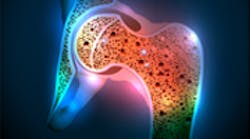It’s all about estrogen: Menopause, bone loss, and periodontal disease
It has been shown that postmenopausal women are more susceptible to bone fractures. (1) Other risk factors include age, ethnicity, gender, family history, previous fractures, menopause, hysterectomy, long-term glucocorticoid therapy, rheumatoid arthritis, and primary or secondary hypogonadism in men. We all lose bone as we age, and lack of estrogen after menopause is a critical risk factor in bone loss. This article will review some recent information about bone loss, and specifically, its relationship to periodontal disease.
RECOMMENDED BY THE AUTHOR | Women's Health and Osteoporosis Clinical Reference
Postmenopausal women susceptible to bone fractures may also be a higher risk for periodontal disease. This was revealed by researchers who found a link between postmenopausal women with high scores on the Fracture Assessment Risk Tool (FRAX). (2) Women can experience a sudden bone loss increase in the first decade after the onset of menopause as estrogen levels decline. In fact, women can lose up to 20% of their bone mass in the 5–7 years after menopause, increasing their risk of osteoporosis. (3) Lower estrogen levels affect bone metabolism and also affect the oral cavity, causing inflammatory changes in the body that can lead to gingivitis.
The researchers were interested in oral-physical connections, and wanted to enable preventive interventions by identifying women at risk for both periodontal disease and osteoporosis. (2) They hypothesized that women at risk for bone fractures might also be at risk for periodontal disease; FRAX scores were considered along with weight, height, previous fractures, rheumatoid arthritis, smoking habits, diabetes, and others.
RELATED READING | What does osteoporosis have to do with oral health?
The researchers concluded that women with high FRAX scores also showed the strongest signs of periodontal disease, suggesting that bone loss scores could provide a reliable indicator of periodontal disease. (2) The World Health Organization (WHO) developed the FRAX tool to evaluate the fracture risk of patients, basing it “on individual patient models that integrate the risks associated with clinical risk factors as well as bone mineral density (BMD) at the femoral neck.” (4) It is a scientifically validated risk assessment tool, endorsed by WHO and now integrated into an increasing number of national osteoporosis guidelines around the world. It is a major breakthrough in helping health professionals to improve identification of patients at high risk of fracture. The web-based FRAX calculator assesses the ten-year risk of osteoporosis fracture based on individual risk factors, with or without bone mineral density (BMD) values.
Osteoporosis should be recognized as important public health concern because of the fractures that result from this condition. BMD is a strong predictor of fracture risk. Women with osteoporosis (BMD T-score ≤-2.5) are at high risk of fracture, but the majority of fractures occur in women with BMD above the osteoporosis threshold (osteopenia), and additional risk factors need to be considered. FRAX identifies those people at highest risk of fracture, and can be used in clinical settings for informed intervention decisions.
References
1. Fixed risk factors. International Osteoperosis Foundation web site. http://www.iofbonehealth.org/fixed-risk-factors. Accessed March 4, 2015.
2. Alli F, Bhandal GK, Thacker HL, Palomo L. Can the FRAX tool be a useful aid for clinicians in referring women for periodontal care? Menopause. 2015;22:75-8.
3. Fast facts. National Osteoperosis Foundation web site. http://users.ipfw.edu/blumenth/Aging/AgingWebSite/NOFFactOsteoporosis.pdf. Accessed March 4, 2015.
4. Welcome to FRAX. World Health Organization Collaborating Center for Metabolic Bone Diseases web site. http://www.shef.ac.uk/FRAX/. Accessed March 4, 2015.
5. Siris ES, Chen YT, Abbott TA, Barrett-Connor E, Miller PD, Wehren LE, et all. Bone mineral density thresholds for pharmacological intervention to prevent fractures. Arch Intern Med. 2004;164:1108–1112
Additional reading
1. Women's Health and Osteoporosis Clinical Reference. American College of Preventive Medicine web site. http://www.acpm.org/?page=WomenOsteoClinRef&hhSearchTerms=%22bone+and+loss+and+menopause%22. Accessed March 4, 2015.










